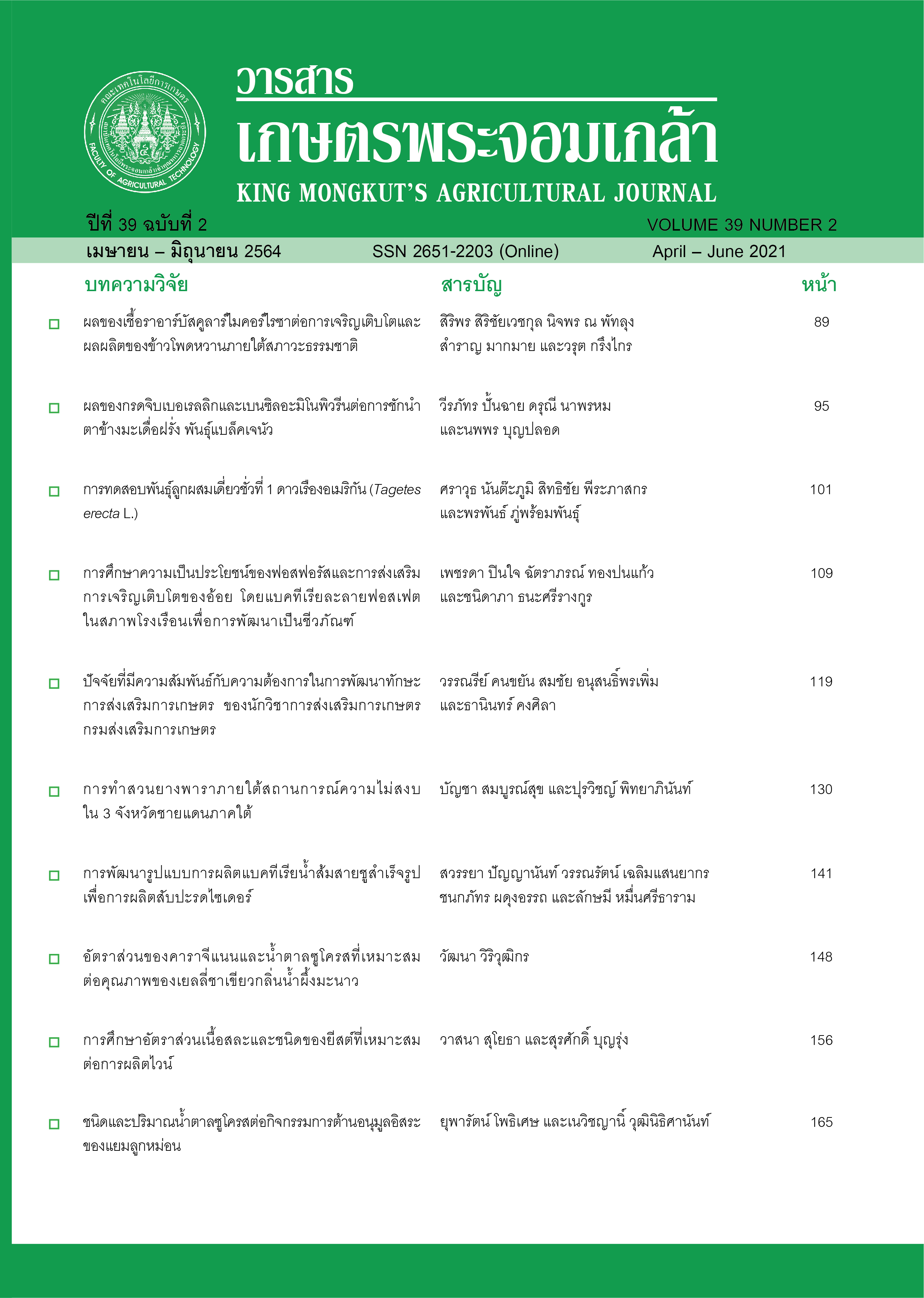ผลของเชื้อราอาบัสคูล่า ไมคอไรซ่าต่างชนิดกันต่อการเจริญเติบโตและผลผลิต ของข้าวโพดหวาน ภายใต้สภาวะธรรมชาติ
Main Article Content
บทคัดย่อ
งานวิจัยนี้มีวัตถุประสงค์เพื่อศึกษาผลของเชื้อราอาร์บัสคูลาร์ไมคอร์ไรซาต่างชนิด ต่อการเจริญเติบโตและผลผลิตของข้าวโพดหวานภายใต้สภาวะธรรมชาติ ดำเนินการทดลองในแปลงขนาด 1x3 เมตร และรองพื้นด้วยปุ๋ยคอกอัตรา 10 ตัน/ไร่ วางแผนการทดลองแบบสุ่มสมบูรณ์ภายในบล็อก 6 วิธีการทดลอง 3 ซ้ำ ได้แก่ 1) ไม่ใส่เชื้อรา 2) Glomus mosseae
3) Scutellospora sp. 4) Glomus sp.+Acualospora sp.1 5) Glomus sp.+Acualospora sp.2 และ 6) ปุ๋ยเคมีสูตร 15-15-15
อัตรา 100 กก./ไร่ พบว่าการใส่เชื้อราอาร์บัสคูลาร์ไมคอร์ไรซาไม่มีผลต่อการเจริญเติบโต (P>0.05) และผลผลิต (P>0.05) ของข้าวโพดหวาน และการใส่เชื้อราอาร์บัสคูลาร์ไมคอร์ไรซาไม่มีผลต่อปริมาณความเข้มข้นฟอสฟอรัส (P>0.05) แมกนีเซียม
(P>0.05) สังกะสี (P>0.05) แมงกานีส (P>0.05) เหล็ก (P>0.05) และซัลเฟอร์ (P>0.05) แต่การใส่เชื้อราอาร์บัสคูลาร์
ไมคอร์ไรซา ทำให้ปริมาณความเข้มข้นของธาตุโพแทสเซียม (P<0.05) และแคลเซียม (P<0.05) เพิ่มขึ้น อย่างไรก็ตาม การใส่เชื้อราอาร์บัสคูลาร์ไมคอร์ไรซา จะเพิ่มปริมาณความเข้มข้นของฟอสฟอรัสในข้าวโพดหวาน โดย Glomus mosseae, Scutellospora sp., Glomus sp.+Acualospora sp.1, Glomus sp.+Acualospora sp.2 จะทำให้ข้าวโพดมีปริมาณความเข้มข้นของฟอสฟอรัสเพิ่มขึ้น 13.1%, 6.0%, 10.2% และ 14.2% ตามลำดับ และการใส่เชื้อราจะทำให้น้ำหนักสดฝักของ
ข้าวโพดหวานเพิ่มขึ้น 14.1-47.4% ภายใต้สภาวะธรรมชาติ
Article Details
วารสารเกษตรพระจอมเกล้า
เอกสารอ้างอิง
พักตร์เพ็ญ ภูมิพันธ์. 2556. ผลของสายพันธุ์ข้าวโพดต่อการพึ่งพาราอาร์บัสคูลาร์ไมคอร์ไรซา. วารสารวิทยาศาสตร์และเทคโนโลยี 2(1): 60-69.
พักตร์เพ็ญ ภูมิพันธ์ และปวีณา ทองเหลือง. 2554. ผลของเชื้อราอาร์บัสคูลาร์ไมคอร์ไรซาท้องถิ่นของชุดดินปากช่องต่อการเจริญเติบโตและ
การดูดใช้ฟอสฟอรัสของข้าวโพดฝักอ่อน ข้าวโพดเลี้ยงสัตว์ และข้าวโพดหวาน. วารสารวิทยาศาสตร์และเทคโนโลยี 19(4): 80-87.
ปริญญาวดี ศรีตนทิพย์, นิจพร ณ พัทลุง, ภัทราภรณ์ ศรีสมรรถการ, พิทักษ์ พุทธวรชัย, นภา ขันสุภา, ยุทธนา เขาสุเมรุ และชิติ ศรีตนทิพย์. 2556. ผลของธาตุอาหาร การขาดน้ำ และไมคอร์ไรซา ต่อปริมาณผลผลิตและสารต้านอนุมูลอิสระในการผลิตผักเชียงดา. รายงานการวิจัย. มหาวิทยาลัยเทคโนโลยีราชมงคลล้านนา, ลำปาง.
Bevege, D. I. 1972. Vesicular-arbuscular mycorrhizas of Araucaria: aspects of their ecology and physiology and role in nitrogen fixation. Ph.D. thesis. University of New England, Armidale, New South Wales.
Choodram, S., Sangwadyai, S., Thuta, T., and Nabhadalung, N. 2017. Using of chemical fertilizer and arbuscular mycorrhizal fungi
to promote growth and yield of INSEE 2 sweet corn. International Journal of Agricultural Technology 13(7.3): 2403-2408.
Hall, I. R. 1978. Effect of vesicular-arbuscular mycorrhizas on two varieties of maize and one of sweetcorn. New Zealand Journal of Agricultural Research 21(3): 517-519.
Liu, A., Hamel, C., Hamilton, R., and Smith, D. 2000. Mycorrhizae formation and nutrient uptake of new corn (Zea mays L.)
hybrids with extreme canopy and leaf architecture as influenced by soil N and P levels. Plant and Soil 221: 157-166.
Liu, A., Hamel, C., Elmi, A., Costa, C., Ma, B., and Smith, D. L. 2002. Concentrations of K, Ca, and Mg in maize colonized by arbuscular mycorrhizal fungi under field conditions. Canadian Journal Soil Science 82: 271-278.
Ifeanyi, A., and Orluchukwu, J. 2018. Response of three varieties of maize (Zea mays) to arbuscular mycorrhizal fungi
(Gigaspora Gigantea). Humid Tropics 4: 30-36.
Khundaram, C., and Nabhadalung, N. 2012. Effects of arbuscular mycorrhizal fungi on growth and yield of baby corn
(Zea mays Linn.) in skeletal soils under non-sterilized soil. In Proc. the Excellence in Teacher Education and Research Innovation. pp. 300-304. Bangkok Thailand.
Mustafa, A. A. A., Othman, R., Abidin, M. A. Z., and Ganesan, V. 2010. Growth response of sweet corn (Zea mays)
to Glomus mosseae inoculation over different plant ages. Asian Journal of Plant Sciences 9: 337-343.
Na Bhadalung, N., Suwanarit, A., Dell, B., Nopamornbodi, O., Thamchaipenet, A., and Rungchuang, J. 2005. Effects of long-term
NP-fertilization on abundance and diversity of arbuscular mycorrhizal fungi under a maize cropping system.
Plant and Soil 270(1): 371-382.
Schenck, N. C., and Schroder, V. N. 1974.Temperature response of Endogone mycorrhiza on soybean roots. Mycologia 66: 600-605.
Smith, S., and Read, D. 2008. Mycorrhizal Symbiosis. 3rded. London: Academic Press.
Subramanian, K. S., Santhanakrishnan, P., and Balasubramanian, P. 2006. Responses of field grown tomato plants to arbuscular mycorrhizal fungal colonization under varying intensities of drought stress. Scientia Horticulturae 107: 245-253.
Tahat, M. M., Kamaruzaman, S., Radziah, O., Kadir, J., and Masdek, H. N. 2008. Response of (Lycopersicum esculentum Mill.)
to different arbuscular mycorrhizal fungi species. Asian Journal of Plant Sciences 7(5): 479-484.
Tas, B. 2014. Effect of the mycorrhiza application on the agronomical properties of sweet corn varieties. Research & Reviews: Journal of Agriculture and Allied Sciences 3(2): 41-47.
Tawaraya, K. 2003. Arbuscular mycorrhizal dependency of different plant species and cultivars. Soil Science and Plant Nutrition 49(5): 655-668.


